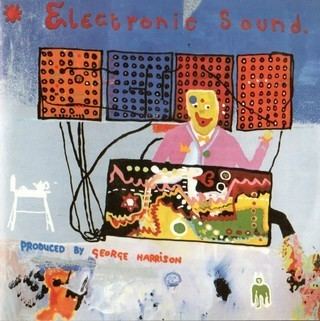Released 9 May 1969 Artist George Harrison Producer George Harrison | Length 43:50 Release date 9 May 1969 Label Zapple Records | |
 | ||
Recorded November 1968; February 1969 Studio Sound Recorders Studio, Los Angeles; Kinfauns (Harrison's home), Surrey Electronic Sound
(1969) All Things Must Pass
(1970) Songs Under the Mersey Wall, No Time or Space Genres Musique concrète, Electronic music Similar George Harrison albums, Experimental music albums | ||
Electronic Sound is the second studio album by George Harrison. Originally released in 1969, it was the second and final record released on the Beatles' short-lived Zapple record label, a subsidiary of Apple Records. The album comprises two lengthy pieces performed on the Moog synthesizer. Harrison subsequently introduced the instrument to the Beatles' sound; the band featured synthesizer for the first time on their 1969 album Abbey Road.
Contents
The first digital edition of Electronic Sound appeared on CD in 1996. Digital editions use a different track order from some of the original vinyl LP copies.
History
Zapple was intended as a creative outlet for avant-garde musical works. The music on Electronic Sound, consisting of two extended instrumental pieces – "Under the Mersey Wall" and "No Time or Space" – was performed on a Moog IIIc modular system. Harrison bought the system directly from Robert Moog and later had it set up at EMI Studios in London for the Beatles to use on their recordings.
According to the album's liner notes, "No Time or Space" was recorded "in California in November 1968 with the assistance of Bernie Krause". The information for "Under the Mersey Wall" reads: "Recorded at Esher in Merrie England; with the assistance of Rupert and Jostick The Siamese Twins – February 1969." Krause later said that "No Time or Space" (UK LP side two, US LP side one) was essentially a recording of him demonstrating the Moog III to Harrison. Krause also claimed that the demonstration was recorded and released without his knowledge or consent. Krause's name was originally credited on the front cover under Harrison's credit, but it was painted over at Krause's insistence. The words "Assisted by Bernie Krause" can nevertheless still be read under the silver ink on original LP pressings. Portions of white noise from "No Time or Space" are used throughout "I Remember Jeep", a track on Harrison's 1970 triple album, All Things Must Pass.
The cover of Electronic Sound was painted by Harrison himself. The inside sleeve included a quotation attributed to Arthur Wax: "There are a lot of people around, making a lot of noise; here's some more."
Release
The album was released on Zapple Records on 9 May 1969 in the UK and on 26 May in the United States. In the UK, the album's catalogue number was Zapple 02, indicating it as the second release on the label after John Lennon and Yoko Ono's similarly experimental Life with the Lions. Electronic Sound failed to chart in the United Kingdom, and barely made the US Billboard Top LPs chart, peaking at number 191. As one of the first financial measures initiated by Allen Klein, the new manager of the Beatles' Apple enterprise, the Zapple label was folded soon after the album's release.
On some vinyl versions of Electronic Sound, such as the original US and Canadian pressings, the order of the recordings was accidentally switched, although the titles were not. This mistake has caused many listeners to confuse the two pieces. When the album was issued on CD for the first time in late 1996, the correct UK running order was used.
Critical reception
In the 2004 Rolling Stone Album Guide, Mac Randall rated the release 2½ stars (out of five) and called the album and its predecessor, Wonderwall Music, "interesting, though only for established fans". Writing for MusicHound, Roger Catlin suggested that Electronic Sound "may interest students of early synthesizer experiments, but nobody else". More impressed, Richard Ginell of AllMusic writes: "Though scoffed at when they were released, these pieces can hold their own and then some with many of those of other, more seriously regarded electronic composers. And when you consider that synthesizers were only capable of playing one note at a time and sounds could not be stored or recalled with the push of a button, the achievement becomes even more remarkable."
Electronic Sound was reissued in remastered CD form on 22 September 2014, as part of the Apple Years 1968–75 Harrison box set. The album was also made available as a high-resolution 24-bit 96 kHz digital download. The synthesizer used on the album is still owned by the Harrison family and is pictured in the centre photo spread of the 2014 CD reissue.
Track listing
All pieces credited to George Harrison. Note: The following is how the titles appear on UK LP versions, CD editions and digital downloads. US and Canadian LP pressings incorrectly switched the order of the recordings but did not switch the titles.
- "Under the Mersey Wall" – 18:41
- "No Time or Space" – 25:10
